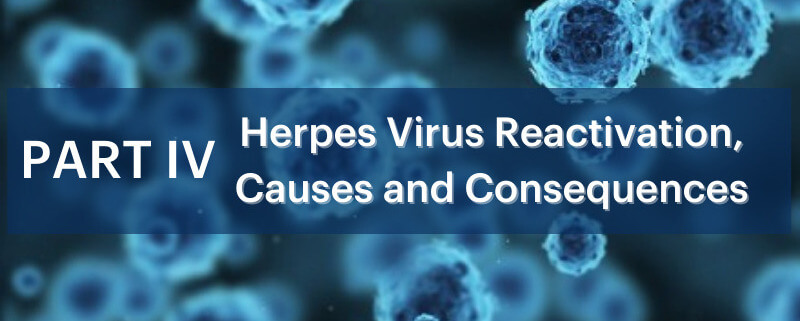INTRODUCTION: This is Part IV in a series presenting reports dealing with the reaction of Herpes viruses during the ongoing SARS-CoV-2 pandemic. Numerous articles came out during 2020 linking Herpes virus reactivations during the pandemic. One of these Herpes viruses, Epstein-Barr Virus (EBV) has also been shown to reactivate during the pandemic. It has been reported that 30% of COVID-19 patients have been shown to experience long-term symptoms following the resolution of the disease, which has led to fatigue, brain fog, and rashes. This has become known as long COVID. An analysis of 185 randomly selected COVID-19 patients was initiated to determine if there was an association between the occurrence of long COVID symptoms and reactivation of EBV (Gold et al.1).
DISCUSSION: Epstein-Barr virus is a human gamma Herpesvirus. Previous studies have shown that 90% of the global population have been infected with EBV, which become dormant after infection. Primary EBV infection is usually asymptomatic when contracted in childhood. A primary infection in adolescence commonly results in infectious mononucleosis. EBV can also switch between lytic and latent phases of its life cycle in many patients. EBV reactivation is identified using serological testing for the presence of EBV early antigen-diffuse (EA-D) IgG or EBV viral capsid antigen (VCA) IgM. A variety of clinical manifestations are associated with EBV reactivation. These include fatigue, psychoneurosis/brain fog, sleep disturbance, arthralgia, pharyngitis, myalgia, headache, fever, gastrointestinal complaints and skin rashes. These are many of the same symptoms attributed to long COVID. Of the 185 randomly selected COVID-19 patients, these researchers (Gold et al) found the 30.3% (56/185) reported long COVID symptoms at least 30 days after testing positive for COVID-19. This group included 13 subjects who were initially asymptomatic for COVID-19. They found 66.7% (20/30) of the long-term long COVID subjects, and only 10% (2/20) of long-term control subjects, were positive for EBV reactivation based on positive titers for EBV EA-D IgG or EBV VCA IgM. They also examined a secondary group of patients who were between 21-90 days (short-term) post-diagnosis of COVID-19. They found a similar level of EBV reactivation among these patients. They found 6/9 (66.7%) of short-term long COVID subjects showed evidence of EBV reactivation based on positive titers for EBV EA-D IgG or EBV VCA IgM. The most frequently reported symptoms among those who were positive for EBV reactivation from both the long-term and short-term long COVID groups were fatigue, insomnia, headaches, myalgia, and confusion. Seven of the long-term subjects of the long COVID group also experienced tinnitus and/or hearing loss. In addition, seven of the subjects in the long-term and 2 in the short-term long COVID with EBV reactivation also experienced frequent skin rashes.
CONCLUSION: Chen et al.2, were the first to document finding EBV reactivation in COVID-19 patients during the acute phase. They found 55.2% of hospitalized COVID-19 patients between January 9, and February 29, in 2020, with serological confirmation of past EBV infection, had serological data indicating EBV reactivation within two weeks of testing positive of SAR-CoV-2. Paolucci et al.3 also observed EBV reactivation in 95.2% (40/42) of ICU patients and in 83.6% (52/62) of sub-intensive care units. Together, these studies suggest COVID-19 infection can lead to long COVID symptoms, possibly due to inflammation induced EBV reactivation.
REFERENCES:
- Gold, Jeffrey, R. A. Okyay, W.E. Licht and D.J. Hurley. (2021). Investigation of Long COVID Prevalence and Its Relationship to Epstein-Barr Virus Reactivation. Pathogens 10, 763. https://doi.org/10.3390/pathogens10060763
- Chen, Ting, J. Song, H. Liu, H. Zheng and C. Chen. (2021). Positive Epstein-Barr virus detection in coronavirus disease 2019 (COVID-19) patients. Sci Rep 11, 10902. https://doi.org/10.1038/s41598-021-90351-y
- Paolucci, S., L. Cassaniti, F. Novazzi, L. Fiorina, A. Piralla, G. Comolli, R. Bruno, R. Maserati, R. Gulminetti, S. Novati. F. Mojoli, F. Baldanti and San Matteo Pavia COVID-19 Task Force. (2020). EBV DNA increase in COVID-19 patients with impaired lymphocyte subpopulation count. Int J Infect Dis. 104;315-319. https://doi.org/10.1016/j.ijid.2020.12.051
MKTG 1064 - Rev A 020322



